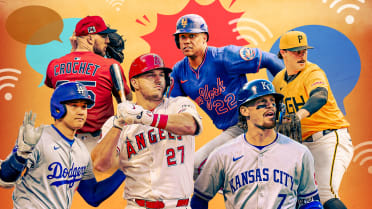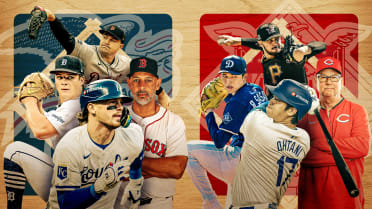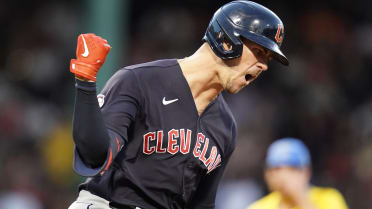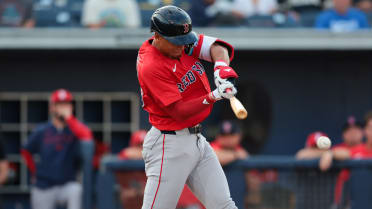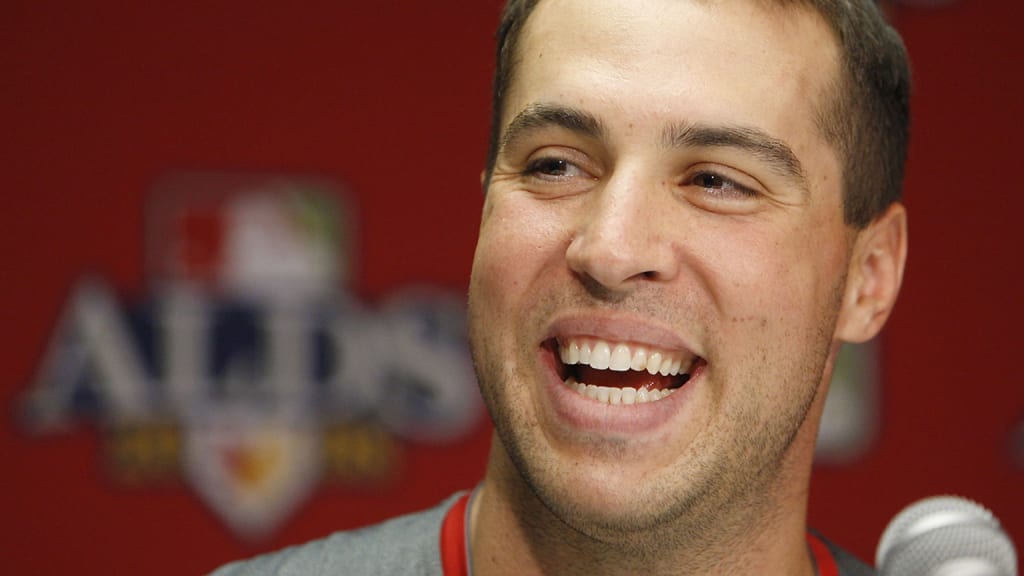
The July non-waiver Trade Deadline was instituted in 1986. For the six decades prior, the Deadline was June 15. So the history of the July (or occasionally early August) Deadline, as we know it, is relatively short. But that doesn't mean it lacks dramatic deals.
Some Deadline deals are overrated. Some are understated. Some move the needle immediately and some are only appreciated with the beneficial lens of retrospect.
With the 2024 Deadline approaching on July 30 at 6 p.m. ET, let's take a look back at the past trades that sent shockwaves across baseball. Here, with the help of hindsight, are my picks for the trade game's five biggest Deadline Earth-shakers (plus some honorable mentions).
1. Angels get Tex … and so much more
Date: July 29, 2008
Details: Mark Teixeira to the Angels; Casey Kotchman and Minor Leaguer Stephen Marek to the Braves
It has been many years since former general manager Tony Reagins made this trade for the Halos, and the club is still feeling the positive effects to this day.
Reagins was looking for a big bat to pair with that of Vladimir Guerrero and further improve an Angels team that had the best record in baseball. Teixeira, an impending free agent whom the Angels had unsuccessfully tried to acquire from Texas a year earlier, was merely a short-term solution, and parting with Kotchman, who was under wraps through 2011, was difficult. But to say the deal worked out is an understatement.
Teixeira was everything the Angels could have possibly hoped for him to be down the stretch. In 54 games, he had a .358/.449/.632 slash line with 13 homers. The Angels advanced to the American League Division Series against the Red Sox, and Teixeira continued to contribute, going 7-for-15 with four walks and four runs scored.
Alas, the Angels lost that series. And that offseason, they lost Teixeira to a Yankees team that signed him to an eight-year, $180 million contract.
But this was back in the days when you could acquire a player midseason and still get Draft pick compensation if he departed in free agency the following offseason. Teixeira was a Type A free agent, so when the Yankees signed him, they forfeited the 25th overall pick in the 2009 Draft to the Angels.
And that's how the Angels basically turned Kotchman into Mike Trout.
2. The Big Unit heads to Houston
Date: July 31, 1998
Details: Randy Johnson to the Astros; Freddy Garcia, Carlos Guillen and a player to be named (John Halama) to the Mariners
Certainly, some Astros fans would label this deal a Deadline dud, given the impact Garcia, Guillen and Halama went on to have with the Mariners (they combined for 33.3 WAR in a Seattle uniform) and the fact that the Astros did not go on to win the World Series.
Again, though, we're talking about blockbusters here -- deals that shook up the industry and then delivered on their stated intent. The Big Unit was brought in as the finishing touch on a loaded Astros team, and you can argue that no midseason acquisition has delivered in a bigger way than Johnson did in those two months in Houston. Those National League lineups didn't know what hit 'em, as Johnson went 10-1 with a 1.28 ERA in 11 starts, giving up just 12 runs on 57 hits with 26 walks and 116 strikeouts in 84 1/3 innings. He went on to allow just three earned runs with 17 strikeouts in 14 NL Division Series innings spread over two starts, but he got only two total runs of support in those games, both losses. The Astros won 102 games that year but were ousted in the NLDS.
Hey, don't blame the Big Unit. He did what he came to do. And the other great thing about this trade is it quite literally was a Deadline deal. Seattle's Woody Woodward and Houston's Gerry Hunsicker agreed to it one minute before midnight, and Hunsicker called the league office with 30 seconds to go.
3. Brewers make a big deal for a big man
Date: July 7, 2008
Details: CC Sabathia to the Brewers; Matt LaPorta, Zach Jackson, Rob Bryson and a player to be named -- Michael Brantley -- to Cleveland
Ultimately, this turned out to be a great baseball trade for both parties.
When a team makes a major Deadline splash, it can only hope for its return to be half as effective as Sabathia was for the Brew Crew. Remember: At the time, the Brewers had not been to the postseason since 1982, and they were a half-game behind the Cardinals in the NL Wild Card race. So merely crossing that October threshold was everything, and Sabathia put them on his back and took them there.
Sabathia pitched an absurd 130 2/3 regular-season innings for Milwaukee in 83 days. He threw seven complete games, including three shutouts, and allowed just 24 earned runs in all. He made each of his last three starts on three days' rest.
Of course, Milwaukee was rather quickly cast out of the NLDS by the Phillies, so perhaps Brewers fans look at the player Brantley (who was added to the deal only if Milwaukee made the playoffs) has become and feel a tinge of frustration. Especially since the Brewers did not recoup a first-round Draft pick when Sabathia signed with the Yankees (whose first-round pick instead went to the Angels, as mentioned above).
But to say the Brew Crew extracted full value out of Sabathia in the second half would be an understatement.
4. Hooray for Mannywood
Date: July 31, 2008
Details: Manny Ramirez to the Dodgers; Andy LaRoche and Bryan Morris (from L.A.) and Craig Hansen and Brandon Moss to the Pirates; Jason Bay to the Red Sox
Seriously, how fun was the summer of '08 in baseball's swap market?
The Red Sox were understandably fed up with Manny's act, especially after he told reporters in the days leading up to the trade, "The Red Sox don't deserve a player like me." What followed was this three-way swap in which the price paid by the Dodgers was negligible in light of the impact Ramirez provided to the middle of their order.
Was Ramirez's act in Boston, where he feigned a knee injury and basically quit on his team, tiresome? Yes. But did he change the scope of a season in L.A.? Absolutely. In 53 games, Manny turned Hollywood into Mannywood by contributing a ridiculous .396/.489/.743 slash line with 17 home runs in 53 games, as the Dodgers won the NL West.
In the playoffs, Ramirez had a .520/.667/1.080 line, helping the Dodgers to their first postseason series win in 20 years before they lost to the eventual World Series champion Phillies in the NLCS.
Despite playing just two months in the NL, Ramirez finished fourth in NL MVP Award voting. That's a blockbuster acquisition, regardless of the events that preceded and followed the deal.
5. A Céspedes for the rest of us
Date: July 31, 2015
Details: Yoenis Céspedes to the Mets; Michael Fulmer and Luis Cessa to the Tigers
Plenty of drama preceded this deal, and I know what you're thinking. Drama? With the Mets? But yes, it's true. Two days earlier, the whole Carlos Gomez non-trade episode, which led to Wilmer Flores tearing up on the field and Sandy Alderson publicly bemoaning social media's impact on the trade process. It was awkward and ugly.
But for the Mets, it couldn't have worked out much better. They pivoted to the rental in Céspedes, who was having a solid-but-not-spectacular season in Detroit. On the surface, it looked risky, given Céspedes' streakiness, but the Mets caught him at just the right moment. For the next six weeks, Céspedes obliterated NL pitching with 17 homers, 10 doubles, three triples and a 1.048 OPS. He cooled off the last couple weeks of September, but he nonetheless received some down-ballot NL MVP Award love and was a central figure in the Mets' surge toward the World Series. Afterward, they decided to keep him around.
Fulmer, meanwhile, was hardly the most touted pitcher in the Mets' system, but he's proved to be an excellent return piece for the Tigers, winning the 2016 AL Rookie of the Year Award and being named to the 2017 AL All-Star team before being beset by injuries.
HONORABLE MENTIONS
Juan Soto to the Padres in 2022: San Diego’s acquisition of Soto and Josh Bell obviously made waves, and the Padres reached the NLCS for the first time since 1998. But because the Padres didn’t reach the playoffs at all in 2023 and then dealt Soto to the Yankees, more attention began to be cast upon the Nationals’ haul of young talent that included C.J. Abrams, MacKenzie Gore, James Wood and others in this sizable swap.
Max Scherzer and Trea Turner to the Dodgers in 2021: Embroiled in a bitter division fight with the rival Giants, the Dodgers took it to the Max in this deal with the Nationals, surrendering prospects Keibert Ruiz, Josiah Gray, Donovan Casey and Gerardo Carrillo to get Scherzer was a rental and a year and two months of control of Turner (who initially played second base before shifting to shortstop when Corey Seager left in free agency). Scherzer and Turner were fantastic for the Dodgers down the stretch, and the Dodgers did down the Giants in the NL Division Series. But the magnitude of this move was sullied some by L.A. falling short of its obvious World Series intent.
Aroldis Chapman to the Cubs in 2016: "If not now, when?" That was Theo Epstein's rationale for renting Chapman on a Cubs club already clearly October-bound. He saw Chapman as the finishing piece, and he was right -- even if Chapman himself wasn't able to finish off Game 7.
Andrew Miller to Cleveland in 2016: This one is often pointed to as a game-changer not just for a Cleveland club that made it to Game 7 of the World Series but for the industry. Terry Francona’s progressive, aggressive use of Miller as early as the fifth inning in the postseason helped his club overcome late-season injuries to starters Carlos Carrasco and Danny Salazar and advance deep into October.
Fred McGriff to the Braves in 1993: The Braves were eight games back of the Giants (remember when those two were weirdly together in the NL West?) when they swung this swap. McGriff helped take care of that with a 1.004 OPS in 68 games down the stretch.
Curt Schilling to the D-backs in 2000: Arizona gave up Travis Lee, Omar Daal, Vicente Padilla and Nelson Figueroa for a year-plus of control of the guy who would pair with Johnson to bring them a World Series title a year later.
Bobby Bonilla to the Pirates in 1986: Another in which the biggest rewards would be reaped later. In exchange for a serviceable pitcher in Jose DeLeon, the Buccos acquired a guy who would win four straight Silver Slugger Awards from 1988-91 and finish in the top three of the NL MVP Award voting in '90 and '91.
Bartolo Colon to the Expos in 2001: A blockbuster in how it turned out for the "seller," as Cleveland's return of "Lee Stevens and prospects" netted them Cliff Lee, Grady Sizemore and Brandon Phillips.
Teixeira to the Braves in 2007: Much like the Colon trade, it was a franchise shaper for the seller, with the Rangers bringing back Elvis Andrus, Neftali Feliz and Matt Harrison, all of whom would play a big role in their back-to-back AL pennants in 2010 and '11.
Mark McGwire to the Cardinals in 1997: Big Mac arrived as a rental, but he signed an extension just before season's end and went on to break Roger Maris' single-season home run record with the Cardinals the next summer.
Doug Fister to the Tigers in 2011: A pretty low-profile trade by the Tigers at the time, but Fister went 8-1 with a 1.79 ERA down the stretch to seal the first of Detroit's four straight division titles.
Carlos Beltran to the Astros in 2004: They gave up Octavio Dotel and John Buck in this three-team trade and brought in a bat that would hit 31 homers for them down the stretch, including eight in the NLDS and NLCS.
Cliff Lee to the Phillies in '09 and the Rangers in '10: Take your pick. In both instances, he was awesome in October to help get his teams to the World Series.
Orlando Cabrera to the Red Sox in 2004: Who would have thought trading Nomar Garciaparra would be the key to the Red Sox ending their 86-year title drought?
July 26 and 28, 2015: The Royals made two separate deals for Johnny Cueto from the Reds and Ben Zobrist from the A's. Taken in total, this was July activity that proved to be an October difference-maker for the world champs.
Anthony Castrovince has been a reporter for MLB.com since 2004.

